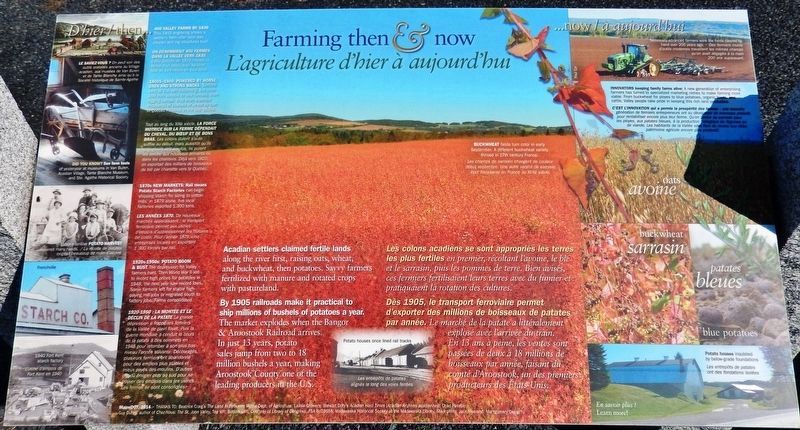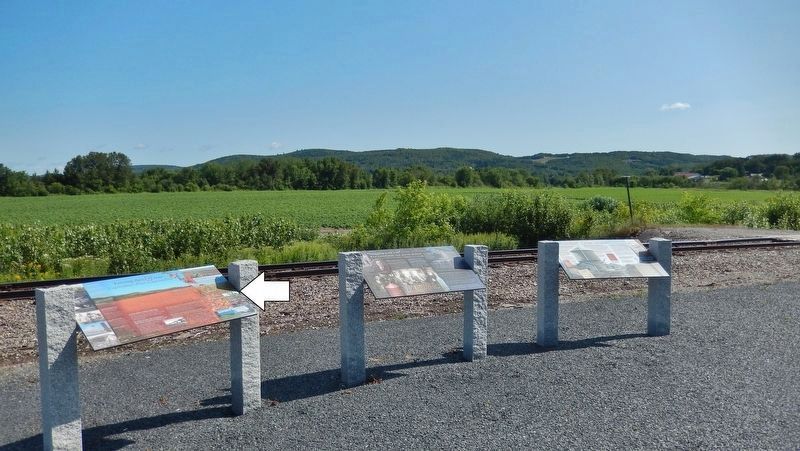Frenchville in Aroostook County, Maine — The American Northeast (New England)
Farming Then & Now / L'agriculture d'hier à aujourd'hui
Inscription.
Acadian settlers claimed fertile lands along the river first, raising oats, wheat, and buckwheat, then potatoes. Savvy farmers fertilized with manure and rotated crops with pastureland.
By 1905 railroads make it practical to ship millions of bushels of potatoes a year. The market explodes when the Bangor & Aroostook Railroad arrives. In just 13 years, potato sales jump from two to 18 million bushels a year, making Aroostook County one of the leading producers in the U.S.
400 Valley Farms by 1830
This 1815 engraving shows a settler's farm after land was cleared and log structures built.
1800s-1900: Powered by Horse, Oxen and Strong Backs.
Settlers were at first self-sustaining, but soon sold their surplus to new farmers, then logging camps. They even exported thousands of bushels of wheat by cart to Quebec Province in the late 1820s.
1870s New Markets: Rail means Potato Starch Factories can begin shipping starch for sizing to cotton mills. In 1879 alone, five local Factories exported 1,300 tons.
1920s-1950s: Potato Boom & Bust. The depression hit Valley farmers hard. Then World War II led to record high prices for potatoes in 1948, the next year saw record lows. Some farmers left for stable high-paying mill jobs or migrated south to factory jobs. Farms consolidated.
Les colons acadiens se sont appropriés les terres les plus fertiles en premier, récoltant l'avoine, le blé et le sarrasin, puis les pommes de terre. Bien avisés, ces fermiers fertilisaient leurs terres avec du fumier et pratiquaient la rotation des cultures.
Dès 1905, le transport ferroviaire permet d'exporter des millions de boisseaux de patates par année. Le marché de la patate a littéralement explosé avec l'arrivée du train. En 13 ans à peine, les ventes sont passées de deux à 18 millions de boisseaux par année, faisant du comté d'Aroostook, un des premiers producteurs des États-Unis.
On Dénombrait 400 Fermes Dans la Vallée vers 1830. Cette gravure de 1815 montre la ferme d'un colon avec sa terre faite et sa maison en bois rond.
Tout au long du XIXè siècle, La Force Motrice sur la Ferme Dépendait du Cheval, du Bœuf et de Bons Bras. Les colons durent s'auto suffire au début, mais aussitôt qu'ils dégagèrent des surplus, ils purent les vendre aux nouveaux arrivants ou dans les chantiers. Déjà vers 1820, on exportait des milliers de boisseaux de blé
par charrette vers le Québec.
Les Années 1870. De nouveaux marchés apparaissent : le transport ferroviaire permet aux usines d'empois d'approvisionner les filatures de coton. Pour l'année 1879, cinq entreprises locales en exportent 1 300 tonnes par rail.
1920-1950 : La Montée et le Déclin de la Patate. La grande dépression a frappé les fermiers de la Vallée de plein fouet. Puis la guerre mondiale a conduit le cours de la patate à des sommets en 1948 pour retomber à son plus bas niveau l'année suivante. Découragés, plusieurs fermiers ont abandonné pour des emplois plus stables et mieux payés des moulins. D'autres ont dû émigrer plus au sud pour se trouver des emplois dans les usines. Les fermes se sont consolidées.
Erected 2014 by Maine Department of Transportation.
Topics. This historical marker is listed in these topic lists: Agriculture • Industry & Commerce • Railroads & Streetcars • Settlements & Settlers.
Location. 47° 16.796′ N, 68° 23.332′ W. Marker is in Frenchville, Maine, in Aroostook County. Marker is on Main Street (U.S. 1) 0.1 miles east of Felix Avenue, on the left when traveling east. Marker is located in a pull-out on the north side of the highway. Touch for map. Marker is at or near this postal address: 308 US Highway 1, Frenchville ME 04745, United States of America. Touch for directions.
Other nearby markers. At least 8 other markers are within 13 kilometers of this marker, measured as the crow flies. "Smuggling is Not a Sin" / « La contrebande n'est pas-un péché! » (here, next to this marker); The "Potato Road" / La route «des patates » (here, next to this marker); Frenchville Railroad Station & Water Tank (about 300 feet away, measured in a direct line); La paroisse de Ste. Luce 150e anniversaire (approx. 1.8 miles away); Archibald Fraser (approx. 6.7 miles away in Canada); Saint David Catholic Church (approx. 11.4 kilometers away); Du Premier Débarquement des Acadiens àu Madawaska (approx. 11.4 kilometers away); Genealogy, Massive French & Acadian Family Reunions (approx. 11.4 kilometers away). Touch for a list and map of all markers in Frenchville.
Credits. This page was last revised on September 26, 2022. It was originally submitted on April 12, 2020, by Cosmos Mariner of Cape Canaveral, Florida. This page has been viewed 172 times since then and 9 times this year. Photos: 1. submitted on April 12, 2020, by Cosmos Mariner of Cape Canaveral, Florida. 2. submitted on April 13, 2020, by Cosmos Mariner of Cape Canaveral, Florida.

